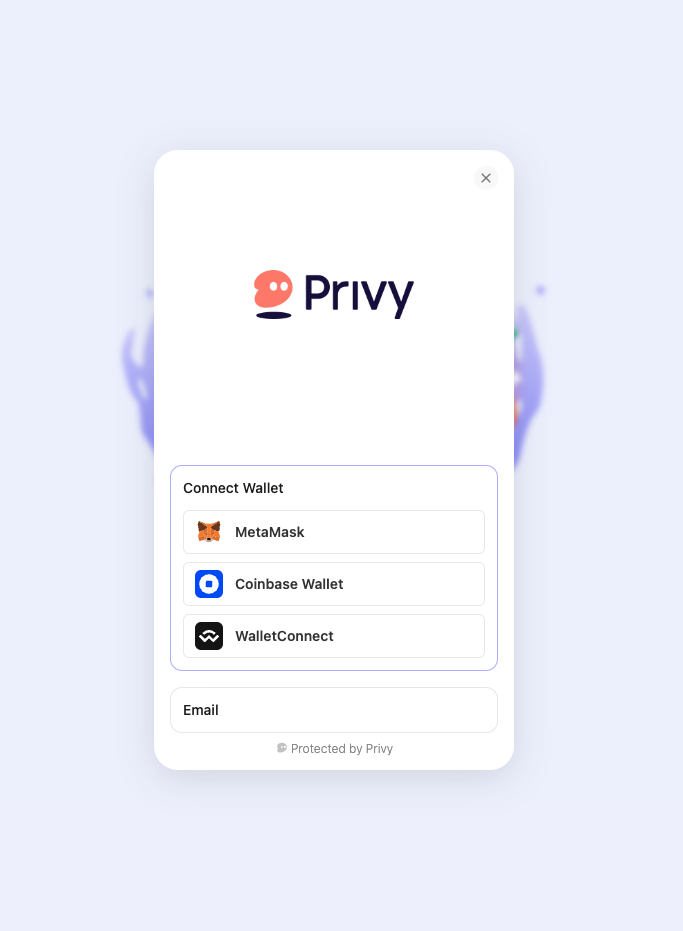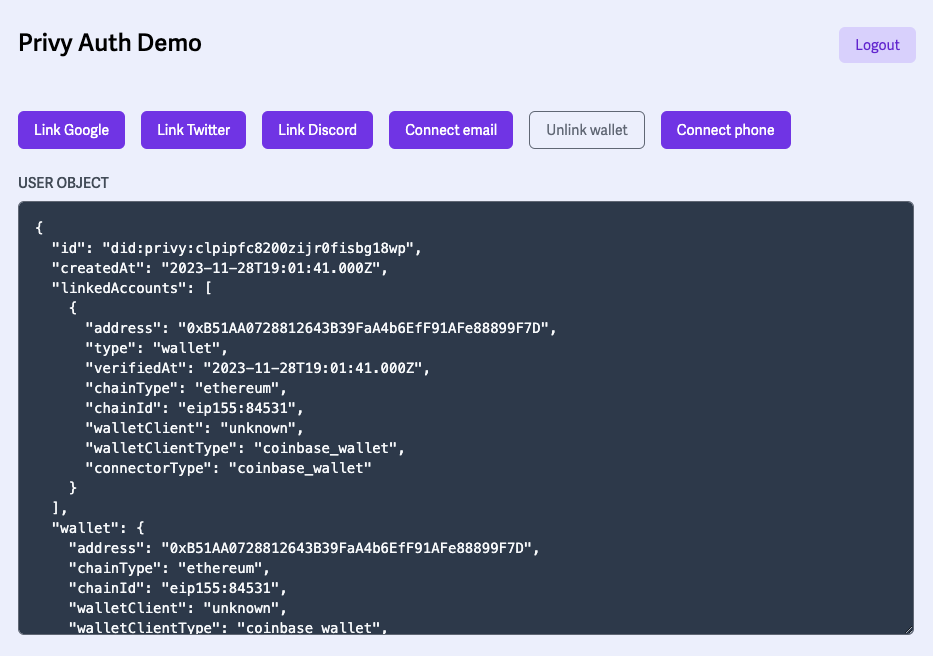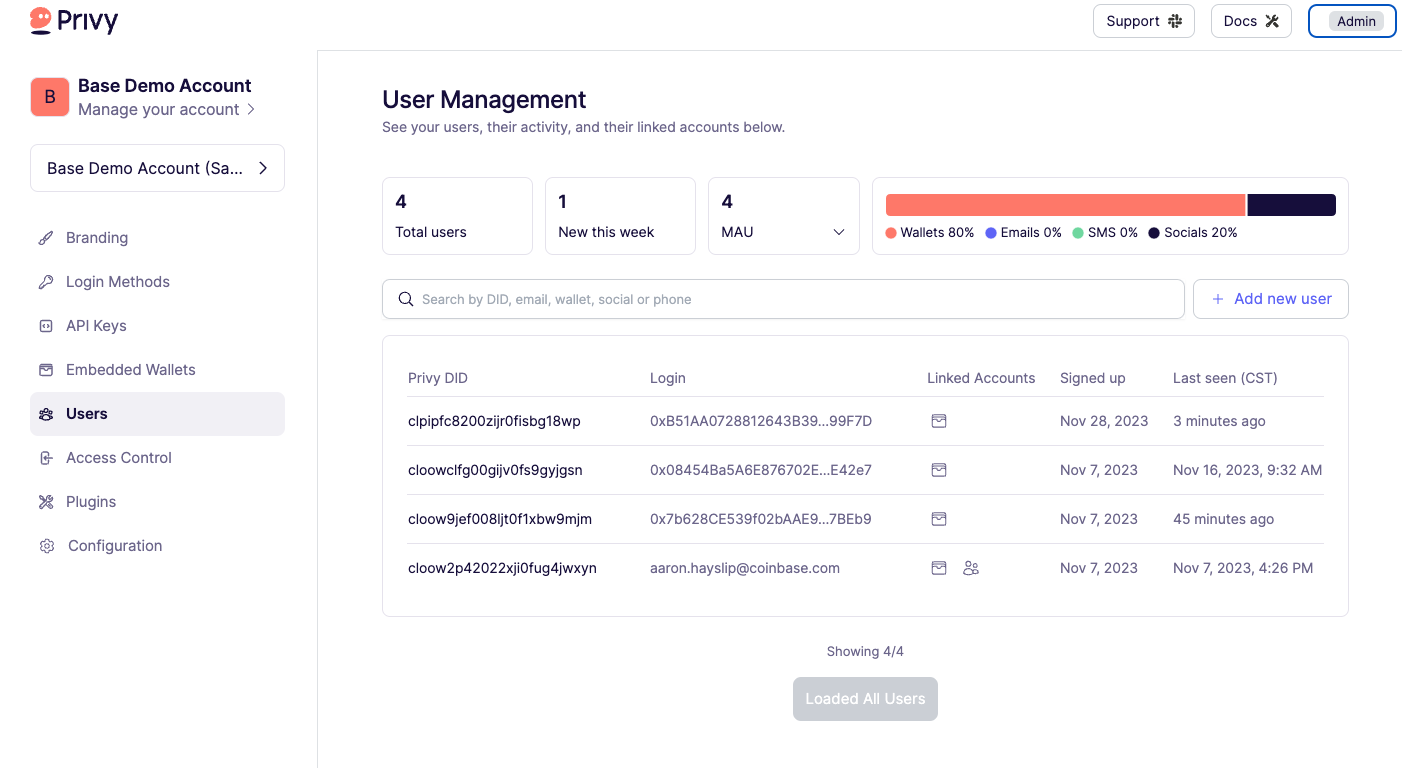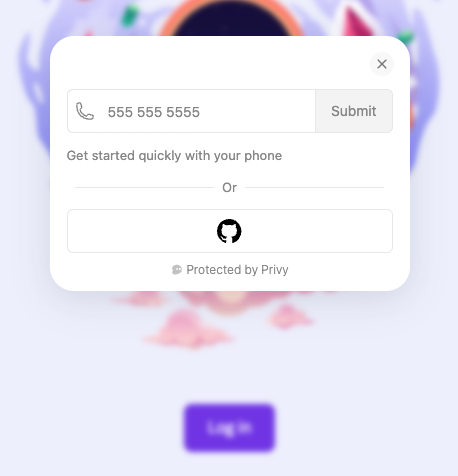Account Abstraction
Account Abstraction on Base using Privy and the Base Paymaster
A tutorial that teaches how to implement Account Abstraction into a Base project using Privy and the Base paymaster.
Account Abstraction on Base using Privy and the Base Paymaster
This tutorial shows you how to use Privy, Alchemy’s Account Kit, and the Base Paymaster to enable your users to use onchain apps without creating a wallet on their own, or even needing to pay for gas fees!Objectives
By the end of this tutorial, you should be able to:Intro to Account Abstraction
- Explain how Account Abstraction can improve user experience for onchain apps
- Describe the difference between contract accounts and EOAs, the limitations of contract accounts, and how EIP-4337 uses
UserOperations to mitigate these limitations - Outline how Account Abstraction works, and how users interact with smart contract wallets
Intro to Privy
- Implement Privy’s quick start to add onchain authentication to a NextJS application
- Compare Privy’s progressive authentication strategy with traditional wallet-based authentication
- Use Privy’s
PrivyProvidercontext andusePrivyhook to implement basic authentication via an email address, SMS, EOA, and/or social auth - Utilize Privy’s Embedded Wallets to enable users to utilize wallet-based actions without having to connect to an external wallet or leave your application
Implementing the Paymaster
- Describe how a third party can use a paymaster to sponsor gas
- Modify Privy’s Base paymaster example example to work in another app, using an EOA to allow a user to call a smart contract function without requiring the user to pay any gas
Prerequisites
1. Be familiar with modern, frontend web development
In this tutorial, we’ll be working with a React frontend built with Next.js. While you don’t need to be an expert, we’ll assume that you’re comfortable with the basics.2. Possess a general understanding of the EVM and smart contract development
This tutorial assumes that you’re reasonably comfortable writing basic smart contracts. If you’re just getting started, jump over to our Base Learn guides and start learning!Intro do Account Abstraction
ERC-4337, also known as Account Abstraction, is a standard that allows smart contracts to initiate transactions, thus enabling any logic that users want to implement to be encoded into the smart contract wallet itself for execution on Ethereum. Account Abstraction has the potential to be a massive game-changer for onchain user experience and many believe it will play a key role in bringing the next billion users onchain.The Problem Account Abstraction Solves
Onchain applications are difficult to use for many people, as they require a lengthy onboarding process for the average internet user who already onchain. For example,the preliminary steps a user needs to go through before they can use an onchain app are:- Create a wallet (Coinbase Wallet, Metamask, etc)
- Store the wallet mnemonic safely, without losing it or compromising it
- Sign a slightly frightening message to connect to an onchain app
- Try to do anything with the app and get a popup asking them to approve a transaction
- Attempt to do so, learn transactions cost gas, and that they don’t have any
- Learn that gas is a fee that users must pay in ETH to use onchain apps
- Attempt to buy ETH, possibly buying the wrong flavor of ETH in the wrong location
- Try the transaction again
- Repeat until they finally find the correct path
- User goes to the onchain app and authenticates (using email, EOA, or social auth)
- User uses the app
- Transactions happen under the hood via a smart contract wallet and the app developer sponsors the user’s gas fees until after they’re onboarded.
- Sponsored Transactions: Allow application owners to cover the users gas fees with a paymaster or allow a user to use something other than ETH (USDC, for example) to cover gas
- Arbitrary Verification Logic: Verify transactions with custom logic
- Account Recovery: Create account recovery features for when user lose private keys
- Batching Transactions: Change the user experience so that multiple transactions can be submitted at once
Overview of ERC-4337 - Account Abstraction
“Account Abstraction” comes from ERC-4337. The proposal itself is a dense read, but one of stated goals of the proposal is to:allow users to use smart contract wallets containing arbitrary verification logic instead of EOAs as their primary account. Completely remove any need at all for users to also have EOAs (as status quo SC wallets and EIP-3074 both require)In other words, the proposal seeks to allow users to use smart contract wallets instead of EOAs to transact onchain.
Privy enables seamless onboarding and wallet creation for users, abstracting away the complexity of private key management. Learn more in the Privy documentation.
- Creating an account costs nothing
- Can initiate transactions
- Transactions between externally-owned accounts can only be ETH/token transfers
- Made up of a cryptographic pair of keys: public and private keys that control account activities
- Creating a contract has a cost because you’re using network storage
- Can only send transactions in response to receiving a transaction
- Transactions from an external account to a contract account can trigger code which can execute many different actions, such as transferring tokens or even creating a new contract
- Contract accounts don’t have private keys. Instead, they are controlled by the logic of the smart contract code
- Change the protocol - hard fork!
- Change transactions, upstream (ERC-4337)
How Account Abstraction Works
With typical Ethereum transactions an EOA initiates and signs a transaction. That transaction is sent to Ethereum’s Public Mempool, is validated and added to a block, onchain. Note that the following steps are primarily happening before any of that.1. Smart Contract Wallet Creation
First, a new smart contract wallet must be created for a user. This wallet is owned by its creator who is designated as the signer. This signer must validate any of its future operations. This wallet may come with a variety of features, but it must be able to at least validateUserOperationss with a function called, validateUserOp. validateUserOp will check each UserOperation’s signature, increment the nonce, and handle the operation’s fees.
2. User Operation Creation
From the smart contract account,UserOperationss are created. These are not yet transactions, but rather represent intents from the user. These intents can represent any onchain user operation.
UserOperation includes the details of the transaction such as sender, nonce, gas limit, max fee per gas, paymaster data (if applicable), and a signature.
3. Signature Generation:
TheUserOperation is then signed using the private key associated with the initiating account. This signature serves to authenticate the transaction and validate that it was indeed initiated by the owner of the smart contract account.
4. Alt Mempool:
ERC-4337 introduces an Alt Mempool where operations are stored until they’re picked up by a Bundler. The Alt Mempool is not very different from the transaction pool typically used in Ethereum, but this mempool exists earlier on in the transaction and holds user operations, where Ethereum’s mempool holds signed transactions.5. Bundler and Operation Submission:
Nodes on the Ethereum network have the option to serve as a Bundler, a role that involves collecting multiple signedUserOperations and consolidating them into a single transaction, called a bundle transaction. These bundle transactions are then directed towards a universal smart contract, called the EntryPoint.
The submission of the signed UserOperation to the EntryPoint contract can be done directly or through a paymaster, which is a contract that agrees to cover the cost of operations for certain users.
6. Operation Validation:
The Bundler triggers a function namedhandleOps on the EntryPoint smart contract, which receives the bundle transaction. The EntryPoint then calls validateUserOp for each account within this bundle transaction.
Each smart contract wallet is then required to implement an additional function and execute the actual operation sent by the EntryPoint contract.
7. Operation Execution:
Once the operation has been validated and the fees have been handled, the operation is executed on the Ethereum network.Intro to Privy
Privy makes authentication and user-management in onchain apps easier by bridging onchain and offchain user data. In preparation to dive into our Base Paymaster example app, this lesson will cover the basics of Privy. In this tutorial, you’ll quick start and review a sample application where users can authenticate with Privy.Overview of Privy
Privy self-describes as “a simple toolkit for progressive authentication in web3”. In this app, you’ll primarily use Privy for its authentication and user-handling capabilities, but some of Privy’s most popular features include: Authentication Options: Privy allows developers to configure how users authenticate. This can be with a crypto wallet, an email address, phone number or social profiles. Conveniently, Privy handles sessions and provides all necessary authentication methods. Progressive Onboarding: Privy creates auser object for each session. Before authentication, this user object is null, but as the user interacts with your application it will progressively associate more user information with this object. For example, users can start by authenticating with their email address and later add their wallet address or any other user information as the application requires.
Embedded Wallets: Embedded wallets are “self-custodial Ethereum wallets that are embedded into your app. This allows your users to take wallet-based actions without ever leaving your site. Embedded wallets are the easiest way to unlock your full product experience for users who don’t have, or don’t want to connect, their own wallet.” Developers can simply configure Privy to automatically created an Embedded Wallet on login or they can be pregenerated on the backend.
Embedded wallets are still EOAs and should not be confused with smart contract wallets. A user may have both. During development, this division can lead to confusing situations where
msg.sender is not the address you were expecting.Privy Quick Start
As with most onchain frontend connector libraries, you can use Privy’s Quick Start to jump start your development with their platform. In this example, you’ll use the NextJS starter.Setup
First, navigate to the repository: https://github.com/privy-io/create-next-app and clone the repo.cd create-next-app and install dependencies with yarn.
Setting Your App Id
To use Privy, you’ll need your own environment variables. In your terminal, run:.env.local file in your project’s root. This is where you’ll add your Privy App ID:
Note - to get an App ID, you’ll need to request one and access it at [https://console.privy.io/]. This process can take a while, but for the Base community, Privy will expedite this process! Developers can send an email to
base@privy.io with:- Your app name
- The email address you want as admin
- A one liner on what you’re building
Starting the App
Finally, runyarn dev and navigate to [http://localhost:3000] to see the starter application.
Privy Login Walkthrough
Before exploring the code, test the app. First, you should see this login page: After clicking “Log in” you’ll see the following modal:
After clicking “Log in” you’ll see the following modal:
 By default, you can login with a wallet, or email.
After logging in, you’ll be redirected to the
By default, you can login with a wallet, or email.
After logging in, you’ll be redirected to the /dashboard page, where the demo app will allow you to connect a number of other accounts to your user object:
 If you navigate to console.privy.io, you’ll see that Privy stores all your users and their data here.
If you navigate to console.privy.io, you’ll see that Privy stores all your users and their data here.

PrivyProvider
Diving into the code, first look at thePrivyProvider inside of _app.jsx:
PrivyProvider uses React Context and wraps any components that will use the usePrivy hook.
Additionally, it’s here that you can pass an optional config property to enable more authentication methods.
Add a config property to the <PrivyProvider /> in _app.jsx with 'github' and 'sms' as the login options:
 You can find a full list of
You can find a full list of loginMethods in the docs for PrivyClientConfig.
The usePrivy Hook
The primary method you’ll use to utilize Privy’s authentication features is usePrivy. Open pages/dashboard.tsx to see the methods decomposed from usePrivy in the starter, and how they are used.
A full list of the fields and methods returned from usePrivy are documented here.
The useWallets Hook
To access wallet data for currently authenticated user, use the useWallets hook:
Embedded Wallets
Lastly, configure your starter app to create an Embedded Wallet for your users on login. As stated in the Privy docs,Embedded wallets are self-custodial Ethereum wallets that are embedded into your app. This allows your users to take wallet-based actions without ever leaving your site. Embedded wallets are the easiest way to unlock your full product experience for users who don’t have, or don’t want to connect, their own wallet.When configuring your app to create embedded wallets on login, you have 2 options:
users-without-wallets: This will create embedded wallets for all use who did not login with an external walletall-users: This will create an additional embedded wallet for all users, regardless if they have linked an external wallet
_app.tsx, update your PrivyProvider:
linkedAccount which is the Privy Embedded Wallet:
Implementing the Paymaster
A paymaster is a type of smart contract account, introduced in ERC-4337, that is able to pay for gas on behalf of another account. In this step-by-step, you’ll modify an example created by Privy, move it to another onchain app, and use it to call a smart contract function. Along the way, you’ll encounter and resolve some of the confusing pitfalls associated with working with smart contract accounts.The tutorial below does not account for recent changes to the Base Paymaster. Please reference the linked repo and adjust. We’ll update the tutorial soon!
Reviewing the Example
Start by reviewing the paymaster example. The address in theabout section of the Github page links to a deployed version of the app. It’s the same app you get from Privy’s Quick Start, with the addition of a mint button (the versions may be a little older).
The app is limited to social auth, so log in with either your Google account or email. You’ll see the dashboard, with the addition of a Mint NFT button at the top.
Click the button and you’ll see a toast notification informing you of updates to the transaction status. Note that this happens without you needing to approve a transaction or fund a wallet!
Click to see the transaction when it’s done to open BaseScan. If you missed it, mint another NFT, it’s not like you’re paying gas!
Reviewing the Transaction and Contract
The transaction page should appear fairly standard. You can see from it that an NFT was minted by the NFT Contract and transferred to the smart wallet address listed on the dashboard. Digging in a little more, you’ll see some things that might be different than what you’d expect.Tokens Transferred and the NFT Contract
In theERC-721 Tokens Transferred section, click the link to NFT Name (NFT) to open up the overview page for the token. You’ll see a list of transfers, with yours likely on the top. Click the address for the contract to open up the view for the contract itself.
You may be surprised to see that there are very few transactions listed for this contract, despite the list of transfers you can see on the token page, or the Events tab. Currently, Etherscan and BaseScan won’t display transactions done via the paymaster.
Blockchain explorers are service providers that provide information about the state of various blockchains. They are not a source of truth.It is possible for onchain activity to be missing from these services.
The Bundler (Transaction Sender)
Return to the transactions summary and look at theFrom: field. It will contain 0x1e6754b227c6ae4b0ca61d82f79d60660737554a. What is this address? It’s not your smart wallet address or signer address. If you mint another NFT from a different login, you’ll get the same sender.
This address is the bundler, which is a special node that bundles user operations from the alt mempool into a single transaction and sends them to the single EntryPoint contract.
EntryPoint
The EntryPoint contract for Base Goerli is located at0x5ff137d4b0fdcd49dca30c7cf57e578a026d2789. Strangely, in your transaction receipt you’ll see that the transaction includes a transfer of ETH from the EntryPoint to the bundler. This transaction is how the bundler gets compensated for performing the service of bundling user ops and turning them into transactions — the EntryPoint calculates the gas used by user ops and multiplies that by the fee percentage and send it to the bundler.
Review the Example Code
Return to the paymaster example and review the readme. The section on Copying into your code lists the three files you’ll need to copy over to implement the paymaster in your own app. All three are extensively documented via comments. You’ll also want to review how the demo app uses these to call a function.SmartAccountContext.tsx
The first file, hooks/SmartAccountContext.tsx uses a React Context provider to create a SmartAccountProvider`` and pass it into your app. You can see it in use in _app.tsx, with the regular PrivyProvider` around it. Review the file in detail.
Starting on line 63, the exported SmartAccountProvider does the following:
- Fetch the user’s wallets and find their Privy wallet. This wallet is provided, and if need be created, by the
PrivyProvider - Set up state variables to manage and share connection status and the smart account itself
- Initialize an RPC client for the Base Paymaster (on Goerli). The URL is hardcoded in
lib/constants.ts - Initialize an ERC-4337 RPC client for Alchemy’s network. This network is where the bundler address comes from
- Create a smart wallet. In this case, the
signeris your EOA embedded wallet created by Privy and fetched in the first step - The EOA address is displayed in the example app as
YOUR SIGNER ADDRESS - Initialize an Alchemy provider for the smart account signer, using Alchemy’s Account Kit.
- This creates the smart account and its address, which is displayed in the example app as
YOUR SMART WALLET ADDRESS
sendSponsoredUserOperation function takes a traditional transaction, turns it into a user operation, adds the data for the paymaster to pay the gas, signs it, and sends it. Whew!
If you want a deeper dive into the inner workings of this process, review the helper functions in user-operations.ts.
How to Call a Smart Contract Function with the Paymaster
Openpages/dashboard.tsx and take a look at the onMint function on line 32. This function is used as the oncClick handler for the Mint button at the top of the dashboard.
If you’re used to working with wagmi, you’ll find the process of sending and awaiting for confirmation of a transaction a little on the manual side. Most of this will be familiar if you’ve used viem directly, or have worked with Ethers.
When a user clicks, the app first creates a viem RpcTransactionRequest for the mint function on the smart contract. The smartContractAddress is supplied by the SmartAccountProvider, and the ABI and contract NFT_ADDRESS are loaded from lib/constants.ts:
awaits first the userOpHash, then the transactionHash, indicating that transaction has completed successfully. It then updates the link in the toast to send the user to that transaction on Goerli BaseScan.
Implementing the Paymaster in your own App
Create a new project using Privy’screate-next-app template, and complete the setup instructions in the readme.
Add an environment variable for NEXT_PUBLIC_ALCHEMY_API_KEY and paste in the an API key for a Base Goerli app. If you need a key, go to add an app and create a new one.
Copying and Updating the Source Files
Copy thehooks and lib folders into your new project. You’ll need to install some more dependencies. Use npm or yarn to add:
- viem
- react-dom
- @alchemy/aa-accounts
- @alchemy/aa-alchemy
- @alchemy/aa-core
SmartAccountContext.tsx in your project. You’ll see an error for getDefaultLightAccountFactory. The name of this function has been updated to getDefaultLightAccountFactoryAddress. Change it in the import, and where it is used in the file in the call to LightSmartContractAccount.
Updating to Use the User’s Wallet
The app is currently configured to find and use the user’s embedded Privy wallet as the signer. To change this, modify the instantiation of theSmartAccountProvider. Instead of finding the user’s Privy wallet:
useEffect to createSmartWallet if there is an embeddedWallet to instead create it if there is a wallet, using that wallet. You’ll also need to update the dependency in the dependency array.
Configuring the PrivyProvider and Adding SmartAccountProvider
By default, thePrivyProvider allows logging in with a wallet or email address. To limit it to only the wallet, update the config. You can also set the default chain here. You’ll need to import baseGoerli to do so.
You also need to import and wrap the app with SmartAccountProvider, imported from hooks/SmartAccountContext.tsx.
The
@alchemy/aa-core package also exports SmartAccountProvider and this export takes precedence when VSCode attempts to help you by automatically adding the import. You’ll know you’ve got the wrong one if SmartAccountProvider generates an error that:Checking Progress
Grab the snippet from the original demo that displays the user’s addresses, and add it todashboard.tsx in the new project:
<p> for the User Object window.
You’ll need to import BASE_GOERLI_SCAN_URL from constants.ts. The useSmartAccount hook returns smartAccountProvider and eoa. Import it and add it under the usePrivy hook. You don’t need them just yet, but go ahead and decompose smartAccountProvider and sendSponsoredUserOperation as well:
YOUR SIGNER ADDRESS!
The app sometimes gets confused with login state after you’ve made changes to
config. If you see the Log In button but clicking it does nothing, try manually navigating to localhost:3000/dashboard or clearing the cache.Calling a Smart Contract Function
You’ve adjusted the foundation of the app to allow you to use the Base Goerli Paymaster with your normal wallet as the signer. Now, it’s time to call a smart contract function. Start by using themint function in the original example. In the DashboardPage component, add a state variable holding an empty element:
onMint function that sets this variable and has the code related to the toast removed.
Note: make sure you change your wallet address in args to make sure the NFT is sent to your EOA wallet address!
For simplicity, we’ve stripped out the code to disable the button while it is minting. You’ll want to implement your own solution to avoid confusing your users!
Calling Another Function
The Base Paymaster on Goerli is very permissive. To call another function, all you need to do is to change theRpcTransactionRequest in sendSponsoredUserOperation to match the address, abi, function name, and arguments of your function on your smart contract.
For example, to call the claim function in the Weighted Voting contract we’ve used in other tutorials, you’d simply need to import the Hardhat-style artifact for the contract and use it to call the function:
The function in this example can only be called once per address. It will then fail, because one wallet cannot claim more than one batch of tokens.

